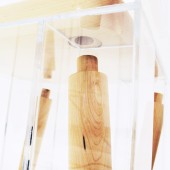Exploded Chair Chair by Joyce Lin |
Home > Winners > #58966 |
 |
|
||||
| DESIGN DETAILS | |||||
| DESIGN NAME: Exploded Chair PRIMARY FUNCTION: Chair INSPIRATION: I have always been fascinated by internal structures and mechanisms, understanding how things work and are interrelated. Just as I am interested in things coming together, I’m also interested in how they fall apart. I wanted to create an object that expresses a state of both connection and disconnection and explores the relationship between the ‘parts’ and the ‘whole' through an illusion of stability and function. UNIQUE PROPERTIES / PROJECT DESCRIPTION: This project features a wooden spindle chair that has been disjointed and encased in clear acrylic boxes. The parts are loose in their compartments, allowing them to shift angles when the chair is moved, creating an illusion of movement while staying in place. The chair is structural, but the acrylic gives the support. The superimposition of one chair form over another emphasizes both the joinery of its parts and the form as a whole, raising questions about the function of a chair versus its physical reality. The title is a reference to exploded view diagrams. OPERATION / FLOW / INTERACTION: Participants who sit on the chair appear to be hovering above the wooden seat. PROJECT DURATION AND LOCATION: The project began in November 2016 and concluded in December 2016. It is on exhibit in the Gelman Gallery in Providence until October 2017, after which it will join a private chair collection in Toronto. FITS BEST INTO CATEGORY: Furniture Design |
PRODUCTION / REALIZATION TECHNOLOGY: The maple wood parts were turned and shaped by hand. The wood was left unfinished but burnished to a smooth surface. The quarter-inch thick panels of acrylic were cut, polished, and constructed around the chair parts using a plastic solvent glue and numerous jig setups. Minor scratches and solvent leaks were carefully removed with a plastic polishing compound. SPECIFICATIONS / TECHNICAL PROPERTIES: Width 406 mm x Length 406 mm x Height 889 mm TAGS: chair, wood, maple, acrylic, plexiglass, conceptual RESEARCH ABSTRACT: My objective in this project was to create a familiar object that expresses a state of both connection and disconnection. I researched a wide variety of shapes and dimensions of common dining chairs before arriving at my personal conception of an archetypal spindle chair form. Further design development was done through AutoCAD and cardboard prototypes. I conducted material tests with acrylic and plastic solvent glue and learned that plastic solvent is best applied quickly with a thin gauge syringe from the concave side of the joint. I also conducted flame and hand polishing tests, concluding that hand polishing gave the best results. CHALLENGE: The primary challenge was in developing an acrylic welding method that would be precise and clean to reduce the amount of spills and squeeze out which would visibly blemish the transparent material. I researched online, contacted museum case display contractors, and adapted their methods to my project, using a series of right angle jigs and squares. Special attention was paid to the timing and order of encasing the parts, given that they would be completely inaccessible once glued. ADDED DATE: 2017-07-15 16:36:31 TEAM MEMBERS (1) : IMAGE CREDITS: All images: Creator Joyce Lin, Exploded Chair, 2016 |
||||
| Visit the following page to learn more: https://www.joyce-lin.com | |||||
| AWARD DETAILS | |
 |
Exploded Chair Chair by Joyce Lin is Winner in Furniture Design Category, 2017 - 2018.· Press Members: Login or Register to request an exclusive interview with Joyce Lin. · Click here to register inorder to view the profile and other works by Joyce Lin. |
| SOCIAL |
| + Add to Likes / Favorites | Send to My Email | Comment | Testimonials | View Press-Release | Press Kit |







